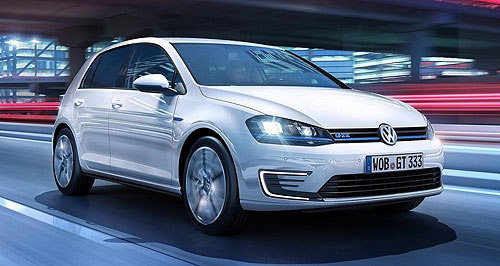Future models - Volkswagen - Golf - GTEGeneva show: Volkswagen electrifies the hot hatchElectric pace: The Golf GTE plug-in hybrid combines hot hatch performance with Holden Volt-equalling fuel use. Volkswagen’s plug-in GTE hot hatch uses just 1.5 litres of fuel per 100km21 Feb 2014 VOLKSWAGEN revealed an electrified Golf hot hatch overnight, appropriately called the GTE plug-in hybrid, but don’t expect to see it on Australian roads any time soon. The addition of a plug-in model means the Golf becomes the first car range available with a full spectrum of vehicle propulsion, with the exception of hydrogen fuel-cell. The GTE joins regular petrol and diesel Golfs, as well as European-market CNG and fully-electric e-Golf models. This is made possible by Volkswagen’s much-hyped MQB modular transverse matrix, a vehicle architecture that can be stretched in multiple directions and which underpins a vast range of VW, Audi, Skoda and Seat vehicles. The reveal of a plug-in Golf comes as small surprise: Volkswagen Group member of the board of management for powertrain development Heinz-Jakob Neusser told GoAuto in Frankurt last September that such a car was on the horizon. The GTE badge was speculated as an obvious fit, though Volkswagen also canvassed Twin Drive as a possible name. “We will have (a) Golf version also with hybridisation which will come from the performance side, the power side, very close to the GTI,” he said. “But I don’t be sure if we call it GTI, or something different.” The GTE joins the petrol GTI and diesel GTD in the range, giving Volkswagen a trio of Golf GTs. However, an Australian release is not on the cards, according to Volkswagen Australia general manager of communications Karl Gehling. VW’s local arm has no plans to offer electrified cars in a market lacking incentives and volume – at this stage, at least. Unlike the existing e-Golf, the GTE is a plug-in hybrid in the same mould as a Holden Volt, meaning it pairs a turbo-petrol engine with a subsidiary electric motor that can be recharged from a wall plug. The difference with the GTE is that Volkswagen has designed with performance in mind as much as efficiency. The result is car that can dash from standstill to 100km/h in 7.6 seconds, but use 1.5 litres of petrol per 100km on the NEDC combined-cycle test. The drivetrain comprises a 110kW version of the 1.4-litre turbo from the regular Golf and a 75kW electric motor linked up to an 8.8kWh lithium-ion battery pack and a specially designed version of VW’s signature six-speed DSG double-clutch automatic transmission. Overall maximum output is 150kW and 350Nm, and it is this torque – available from zero rpm with the electric motor – that sets the GTE’s performance apart from other PHEVs. All-electric range is 50km, and the car can be fully charged from a regular wall socket in 3.5 hours (or 2.5 from a public station). The overall maximum driving range – meaning until the petrol tank is depleted – is 934km. Volkswagen states the battery weights 120kg, while the overall vehicle mass is 1527kg. Volkswagen has tweaked the suspension settings to account for the extra mass over the GTI, promising sporty handling. The cabin is familiar hot Golf, though the GTI’s red accents have been switched to blue. There are numerous graphics on screens depicting energy use and charge levels, while a downloadable app can tweak vehicle setting remotely. The GTE is a small part of Volkswagen’s global ambition to be the world-leader in electric vehicles by 2018, as stated last September by chief executive Martin Winterkorn, who said up to 40 EV models could be developed across the group. The rapid rollout of the MQB architecture, which will underpin up to 80 per cent of the range from 2018, means the company can quickly and easily add electrified vehicles in most key segments. “We're not talking about two or three niche models – that's not what we're doing,” Dr Winterkorn said at the time. “Volkswagen has put electric mobility into the heart of our group and as a result we have met all the requirements to make the Volkswagen Group number one by 2018 in the field of electric vehicles.”  Read moreAll motor show Alfa Romeo Alfa Romeo Abarth Abarth Audi Audi Aston Martin Aston Martin BMW BMW Bentley Bentley Chrysler Chrysler Chevrolet Chevrolet Dodge Dodge Citroen Citroen Ferrari Ferrari DS DS Ford Ford Fiat Fiat FPV FPV Foton Foton Haval Haval Great Wall Great Wall Honda Honda Holden Holden Hyundai Hyundai HSV HSV Isuzu Isuzu Infiniti Infiniti Jeep Jeep Jaguar Jaguar Lamborghini Lamborghini Kia Kia Lexus Lexus Land Rover Land Rover Mazda Mazda Maserati Maserati Mercedes-Benz Mercedes-Benz McLaren McLaren Mini Mini Nissan Nissan Mitsubishi Mitsubishi Peugeot Peugeot Opel Opel Proton Proton Porsche Porsche Renault Renault Ram Ram Saab Saab Rolls-Royce Rolls-Royce Smart Smart Skoda Skoda Subaru Subaru SsangYong SsangYong Tesla Tesla Suzuki Suzuki Toyota Toyota Volvo VolvoMotor industry news |
Click to shareAll motor show Alfa Romeo Alfa Romeo Abarth Abarth Audi Audi Aston Martin Aston Martin BMW BMW Bentley Bentley Chrysler Chrysler Chevrolet Chevrolet Dodge Dodge Citroen Citroen Ferrari Ferrari DS DS Ford Ford Fiat Fiat FPV FPV Foton Foton Haval Haval Great Wall Great Wall Honda Honda Holden Holden Hyundai Hyundai HSV HSV Isuzu Isuzu Infiniti Infiniti Jeep Jeep Jaguar Jaguar Lamborghini Lamborghini Kia Kia Lexus Lexus Land Rover Land Rover Mazda Mazda Maserati Maserati Mercedes-Benz Mercedes-Benz McLaren McLaren Mini Mini Nissan Nissan Mitsubishi Mitsubishi Peugeot Peugeot Opel Opel Proton Proton Porsche Porsche Renault Renault Ram Ram Saab Saab Rolls-Royce Rolls-Royce Smart Smart Skoda Skoda Subaru Subaru SsangYong SsangYong Tesla Tesla Suzuki Suzuki Toyota Toyota Volvo VolvoMotor industry news |


























Facebook Twitter Instagram